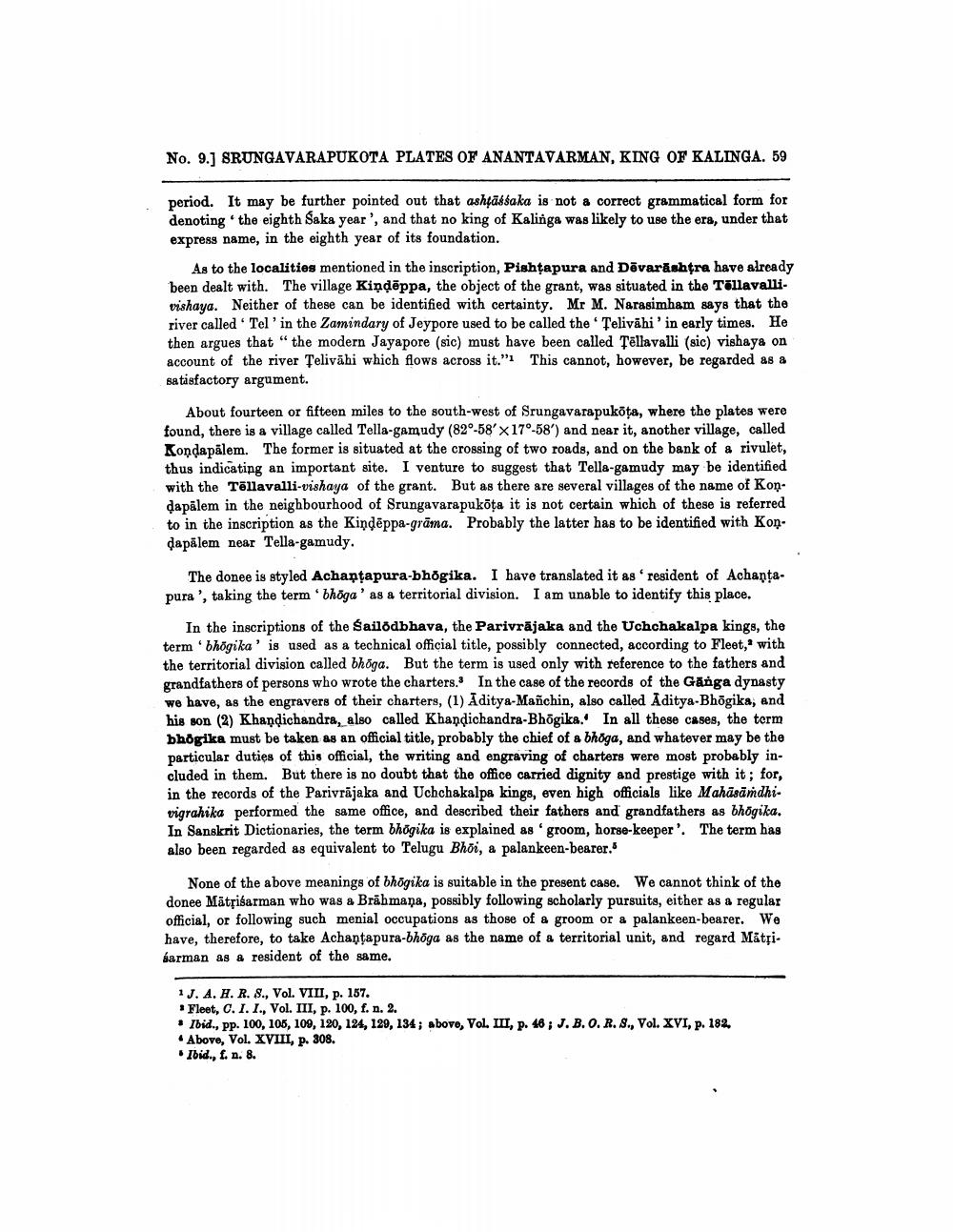________________
No. 9.1 SRUNGAVARAPUKOTA PLATES OF ANANTAVARMAN, KING OF KALINGA. 59
period. It may be further pointed out that ashţātsaka is not a correct grammatical form for denoting the eighth Saka year', and that no king of Kalinga was likely to use the era, under that express name, in the eighth year of its foundation.
As to the localities mentioned in the inscription, Pishtapura and Dāvarāshtra have already been dealt with. The village Kiņdēppa, the object of the grant, was situated in the Tallavallivishaya. Neither of these can be identified with certainty. Mr M. Narasimham says that the river called 'Tel'in the Zamindary of Jeypore used to be called the Telivähi' in early times. He then argues that "the modern Jayapore (sic) must have been called Tellavalli (sic) vishaya on account of the river Telivāhi which flows across it.". This cannot, however, be regarded as a satisfactory argument.
About fourteen or fifteen miles to the south-west of Srungavarapukõţa, where the plates were found, there is a village called Tella-gamudy (820-58' x 170-58') and near it, another village, called Kondapālem. The former is situated at the crossing of two roads, and on the bank of a rivulet, thus indicating an important site. I venture to suggest that Tella-gamudy may be identified with the Tēllavalli-vishaya of the grant. But as there are several villages of the name of Kon. dapālem in the neighbourhood of Srungavarapukota it is not certain which of these is referred to in the inscription as the Kindēppa-grāma. Probably the latter has to be identified with Kon. dapālem near Tella-gamudy.
The donee is styled Achantapura-bhogika. I have translated it as resident of Achantapura', taking the term bhöga' as a territorial division. I am unable to identify this place.
In the inscriptions of the Sailodbhava, the Parivrājaka and the Uchchakalpa kings, the term 'bhögika' is used as a technical official title, possibly connected, according to Fleet, with the territorial division called bhöga. But the term is used only with reference to the fathers and grandfathers of persons who wrote the charters. In the case of the records of the Ganga dynasty we have, as the engravers of their charters, (1) Aditya-Mañchin, also called Aditya-Bhögika, and his son (2) Khandichandra, also called Khandichandra-Bhögika. In all these cases, the term bhogika must be taken as an official title, probably the chief of a bhöga, and whatever may be the particular duties of this official, the writing and engraving of charters were most probably included in them. But there is no doubt that the office carried dignity and prestige with it; for, in the records of the Parivrājaka and Uchchakalpa kings, even high officials like Mahāsāṁdhi. vigrahika performed the same office, and described their fathers and grandfathers as bhogika. In Sanskrit Dictionaries, the term bhogika is explained as 'groom, horse-keeper'. The term has also been regarded as equivalent to Telugu Bhõi, a palankeen-bearer.
None of the above meanings of bhõgika is suitable in the present case. We cannot think of the donee Mātsišarman who was a Brāhmana, possibly following scholarly pursuits, either as a regular official, or following such menial occupations as those of a groom or a palankeen-bearer. We have, therefore, to take Achanțapura-bhoga as the name of a territorial unit, and regard Mätsi. sarman as a resident of the same.
1 J. A. H. R. 8., Vol. VIII, p. 157. * Fleet, C.1.1., Vol. III, p. 100, f. n. 2. • Ibid., pp. 100, 105, 100, 120, 124, 129, 134; above, Vol. III, p. 46; J. B.O.R. 8., Vol. XVI, p. 182 . Above, Vol. XVIII, p. 308.
Ibid., f. n. 8.




